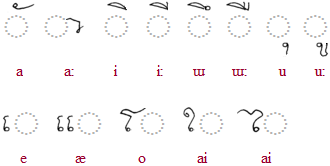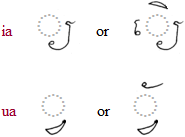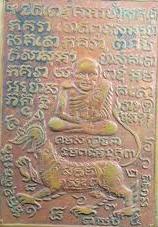This is an old Thai script sometimes found in religious documents, and still commonly used for labeling amulets, magical pictures (yantras) and Thai tattoos. It it mainly used for writing in the Pali language. Khom Thai has clear similarities with the Khmer script of Cambodia; indeed both Thai and Khmer derive from an ancient script called Khom, which in turn derives from Pallava.
Consonants
Each letter has a full form and a subscript form which is written underneath a syllable’s initial consonant, in a similar way to Lanna. The chart here is in traditional Brahmic order, and the subscript forms are written together with their full form. Below each is the equivalent modern Thai letter and its IPA representation. Note that subscript /r/ is a wraparound prefix.
Some modern Thai letters are missing from this set. In particular, the following modern Thai letters each have a couple of options in Khom Thai:
Vowels
The diacritic vowels are almost exactly the same as in modern Thai. Note that the /a:/ glyph attaches directly to the top-right of its consonant, as in Khmer.
But there are some special spellings. For example, medial /a/ may be omitted and the final consonant written twice (as was the case in Ramkhamhaeng’s script). These are different, too:
There are special glyphs for initial vowels:






